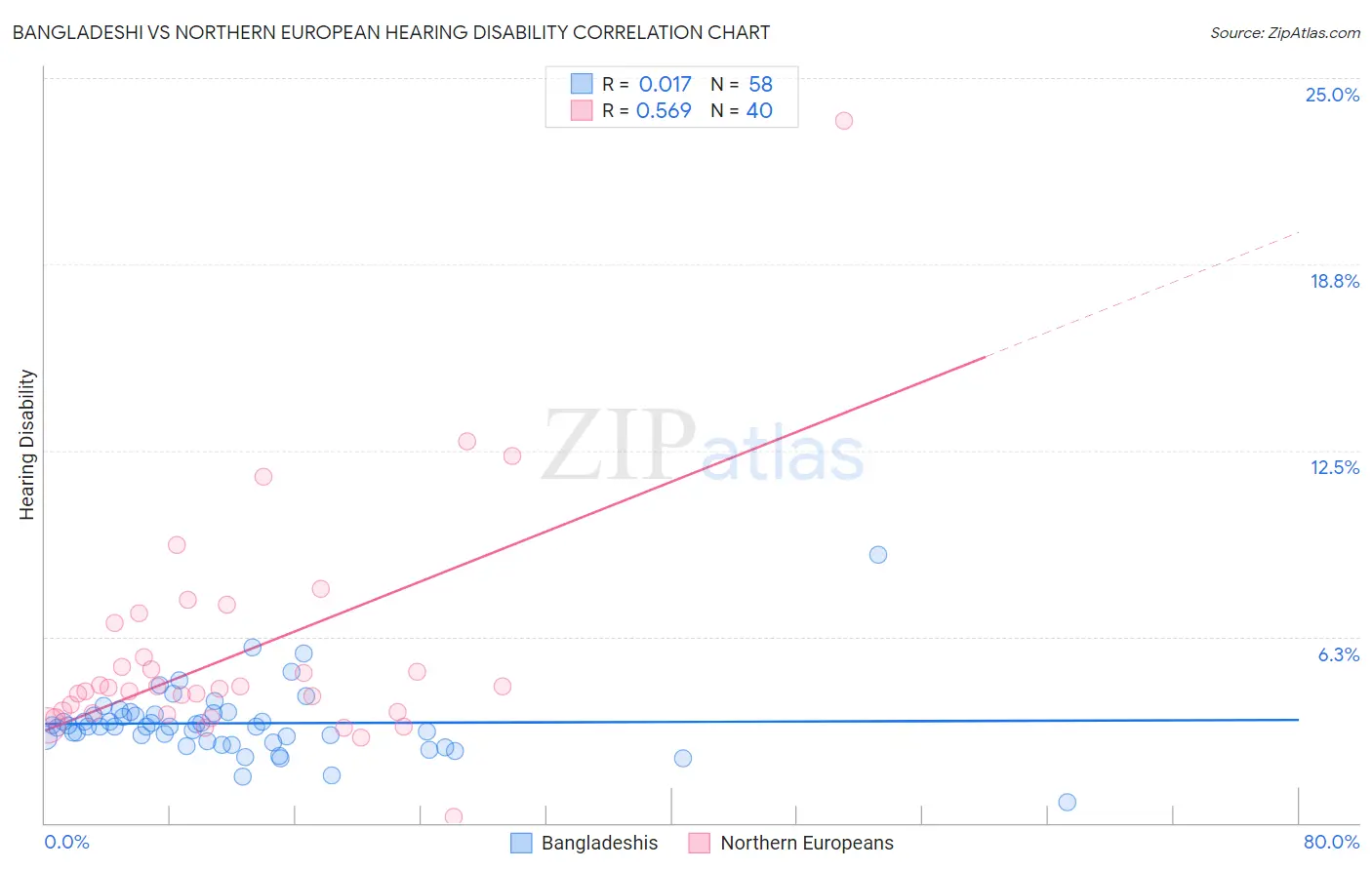Bangladeshi vs Northern European Hearing Disability
COMPARE
Bangladeshi
Northern European
Hearing Disability
Hearing Disability Comparison
Bangladeshis
Northern Europeans
3.2%
HEARING DISABILITY
8.1/ 100
METRIC RATING
215th/ 347
METRIC RANK
3.4%
HEARING DISABILITY
0.2/ 100
METRIC RATING
258th/ 347
METRIC RANK
Bangladeshi vs Northern European Hearing Disability Correlation Chart
The statistical analysis conducted on geographies consisting of 141,366,446 people shows no correlation between the proportion of Bangladeshis and percentage of population with hearing disability in the United States with a correlation coefficient (R) of 0.017 and weighted average of 3.2%. Similarly, the statistical analysis conducted on geographies consisting of 405,970,719 people shows a substantial positive correlation between the proportion of Northern Europeans and percentage of population with hearing disability in the United States with a correlation coefficient (R) of 0.569 and weighted average of 3.4%, a difference of 8.9%.

Hearing Disability Correlation Summary
| Measurement | Bangladeshi | Northern European |
| Minimum | 0.71% | 0.22% |
| Maximum | 9.0% | 23.6% |
| Range | 8.3% | 23.4% |
| Mean | 3.3% | 5.7% |
| Median | 3.2% | 4.5% |
| Interquartile 25% (IQ1) | 2.8% | 3.7% |
| Interquartile 75% (IQ3) | 3.7% | 6.2% |
| Interquartile Range (IQR) | 0.90% | 2.4% |
| Standard Deviation (Sample) | 1.2% | 3.9% |
| Standard Deviation (Population) | 1.2% | 3.8% |
Similar Demographics by Hearing Disability
Demographics Similar to Bangladeshis by Hearing Disability
In terms of hearing disability, the demographic groups most similar to Bangladeshis are Australian (3.2%, a difference of 0.010%), Immigrants from Norway (3.2%, a difference of 0.24%), Russian (3.2%, a difference of 0.32%), Immigrants from Northern Europe (3.2%, a difference of 0.35%), and New Zealander (3.2%, a difference of 0.41%).
| Demographics | Rating | Rank | Hearing Disability |
| Immigrants | Latvia | 12.7 /100 | #208 | Poor 3.1% |
| Immigrants | Hungary | 12.5 /100 | #209 | Poor 3.1% |
| Cape Verdeans | 12.2 /100 | #210 | Poor 3.1% |
| Romanians | 12.1 /100 | #211 | Poor 3.1% |
| Pakistanis | 11.1 /100 | #212 | Poor 3.1% |
| Immigrants | Iraq | 10.5 /100 | #213 | Poor 3.1% |
| Australians | 8.1 /100 | #214 | Tragic 3.2% |
| Bangladeshis | 8.1 /100 | #215 | Tragic 3.2% |
| Immigrants | Norway | 7.3 /100 | #216 | Tragic 3.2% |
| Russians | 7.1 /100 | #217 | Tragic 3.2% |
| Immigrants | Northern Europe | 7.0 /100 | #218 | Tragic 3.2% |
| New Zealanders | 6.8 /100 | #219 | Tragic 3.2% |
| Malaysians | 6.6 /100 | #220 | Tragic 3.2% |
| Immigrants | Laos | 6.6 /100 | #221 | Tragic 3.2% |
| Immigrants | Oceania | 6.5 /100 | #222 | Tragic 3.2% |
Demographics Similar to Northern Europeans by Hearing Disability
In terms of hearing disability, the demographic groups most similar to Northern Europeans are Yaqui (3.4%, a difference of 0.070%), Slovene (3.5%, a difference of 0.24%), Portuguese (3.5%, a difference of 0.32%), Hawaiian (3.5%, a difference of 0.35%), and Immigrants from North America (3.5%, a difference of 0.47%).
| Demographics | Rating | Rank | Hearing Disability |
| Hungarians | 0.4 /100 | #251 | Tragic 3.4% |
| Croatians | 0.4 /100 | #252 | Tragic 3.4% |
| Carpatho Rusyns | 0.3 /100 | #253 | Tragic 3.4% |
| Slavs | 0.2 /100 | #254 | Tragic 3.4% |
| Poles | 0.2 /100 | #255 | Tragic 3.4% |
| Hmong | 0.2 /100 | #256 | Tragic 3.4% |
| Yaqui | 0.2 /100 | #257 | Tragic 3.4% |
| Northern Europeans | 0.2 /100 | #258 | Tragic 3.4% |
| Slovenes | 0.1 /100 | #259 | Tragic 3.5% |
| Portuguese | 0.1 /100 | #260 | Tragic 3.5% |
| Hawaiians | 0.1 /100 | #261 | Tragic 3.5% |
| Immigrants | North America | 0.1 /100 | #262 | Tragic 3.5% |
| Immigrants | Canada | 0.1 /100 | #263 | Tragic 3.5% |
| Immigrants | Germany | 0.1 /100 | #264 | Tragic 3.5% |
| British | 0.1 /100 | #265 | Tragic 3.5% |